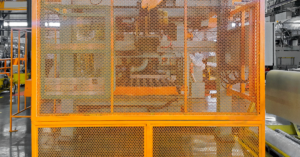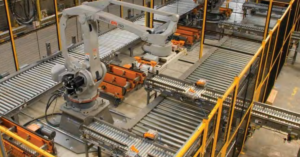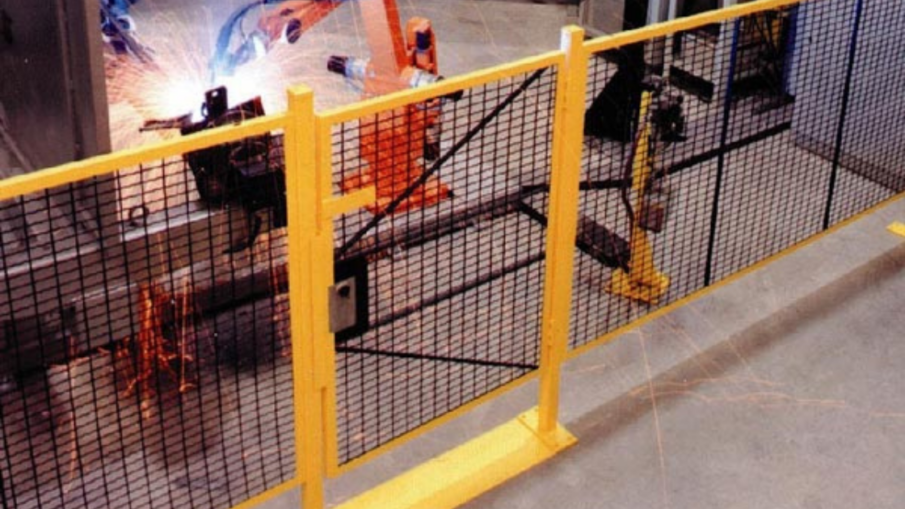Fencing systems play a critical role in ensuring the safety and efficiency of industrial operations. Whether they are used to enclose robotic cells, define restricted zones, or provide perimeter guarding, customized fencing systems can adapt to the unique needs of your facility. The key to designing an effective fencing system lies in selecting the right wire mesh sizes, heights, and finishes for your specific application.
This blog explores the factors to consider when customizing fencing systems, their benefits, and tips for ensuring compliance and durability.
The Importance of Fencing Systems in Industrial Safety
Industrial fencing systems are more than just barriers; they are essential components of a comprehensive machine guarding solution. Designed to prevent unauthorized access and protect workers from hazards, these systems help facilities comply with safety regulations such as OSHA Machine Guarding Standards and ISO 13849. Proper training is essential for effective machine safety.
Benefits of a Well-Designed Fencing System:
- Enhanced Worker Safety: Prevent accidental entry into dangerous zones.
- Operational Efficiency: Maintain clear boundaries without interrupting workflows.
- Custom Fit: Tailor designs to accommodate machinery layouts and facility needs.
1. Choosing the Right Wire Mesh Size

Wire mesh size is one of the most important factors when designing a fencing system. The size of the mesh determines the level of visibility, ventilation, and protection provided.
Common Mesh Size Options:
- Small Mesh (1” x 1” or smaller):
- Use Case: Ideal for areas where small objects or debris must be contained, such as near grinders or welding stations.
- Benefit: Prevents small tools or parts from passing through.
- Medium Mesh (1.5” x 1.5” to 2” x 2”):
- Use Case: Suitable for general-purpose guarding around robotic systems or conveyors.
- Benefit: Provides a balance of visibility and protection.
- Large Mesh (3” x 3” or larger):
- Use Case: Used in low-risk zones where visibility and airflow are priorities.
- Benefit: Allows for maximum ventilation and line-of-sight monitoring.
Pro Tip: Choose mesh sizes based on the level of risk in the area. For high-risk zones, opt for smaller mesh sizes to provide more comprehensive protection.
2. Determining the Ideal Fence Height

The height of your fencing system is critical for ensuring adequate protection. Fences that are too low may allow workers to climb over or reach into restricted zones, while overly tall fences may obstruct visibility.
Height Recommendations for Common Applications:
- Low-Risk Areas:
- Height: 4-5 feet.
- Use Case: Low-hazard zones where fencing serves as a boundary marker rather than a safety barrier.
- Medium-Risk Areas:
- Height: 6-7 feet.
- Use Case: Robotic cells or conveyor systems where workers need to stay clear of moving parts.
- High-Risk Areas:
- Height: 8 feet or higher.
- Use Case: Enclosing heavy machinery, welding areas, or hazardous material zones.
Pro Tip: Consider adding extensions like wire panels or angled tops for extra security in high-risk areas.
3. Selecting the Best Finish for Your Fencing System

The finish of your fencing system impacts both its durability and appearance. Environmental conditions, such as exposure to moisture, chemicals, or extreme temperatures, should guide your selection.
Popular Fencing Finishes:
- Powder Coating:
- Use Case: Indoor applications where durability and aesthetics are priorities.
- Benefit: Resistant to scratches, rust, and general wear and tear.
- Galvanized Coating:
- Use Case: Outdoor installations or facilities with high humidity.
- Benefit: Protects against rust and corrosion in harsh environments.
- Stainless Steel:
- Use Case: High-risk environments, such as food processing plants or chemical facilities.
- Benefit: Offers maximum resistance to corrosion and requires minimal maintenance.
Pro Tip: Choose a finish that matches your facility’s environment to reduce maintenance costs and extend the lifespan of your fencing system.
4. Additional Customization Options
Beyond wire mesh size, height, and finish, other customization options can enhance the functionality and safety of your fencing system.
Access Points and Gates:
- Sliding Gates: Save space in tight areas.
- Hinged Doors: Offer quick access for maintenance personnel.
- Interlocked Gates: Prevent machinery from operating when gates are open.
Color Coding:
- Use colors to indicate the purpose of different zones (e.g., red for restricted areas, yellow for caution zones).
Integrated Safety Devices:
- Install safety light curtains or interlock switches to enhance protection at access points.
Ensuring Compliance and Longevity
Proper installation and maintenance of fencing systems are critical to their effectiveness. Follow these best practices to ensure compliance and durability:
Compliance Tips:
- Reference OSHA Machine Guarding Standards and ISO 13849 to meet safety requirements.
- Ensure fencing heights and access points comply with industry regulations.
Maintenance Guidelines:
- Conduct regular inspections for damage or corrosion.
- Tighten loose bolts and ensure gates operate smoothly.
- Replace worn or damaged components promptly.
Real-World Applications of Customized Fencing Systems
Case Study: Automotive Plant
A large automotive facility installed fencing systems with 1” x 1” mesh, an 8-foot height, and galvanized finishes to enclose robotic cells. The customization prevented debris from escaping, protected workers, and withstood the plant’s high humidity conditions.
Case Study: Food Processing Plant
A food processing plant opted for stainless steel fencing with interlocked gates to meet stringent hygiene and safety standards. The system’s finish minimized corrosion and ensured long-term durability.
Customizing Your Fencing System for Maximum Safety
Tailoring your fencing system’s wire mesh size, height, and finish is essential for creating a safe and efficient workspace. By considering your facility’s unique needs, environmental conditions, and compliance requirements, you can design a system that protects workers, enhances productivity, and stands the test of time.

